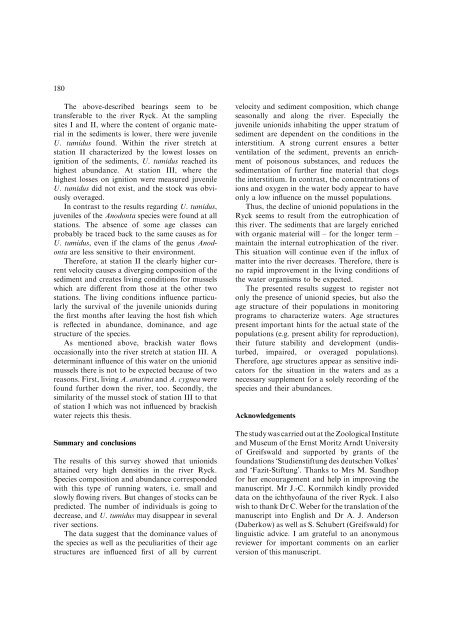Population size and structure of three mussel species (Bivalvia ...
Population size and structure of three mussel species (Bivalvia ...
Population size and structure of three mussel species (Bivalvia ...
You also want an ePaper? Increase the reach of your titles
YUMPU automatically turns print PDFs into web optimized ePapers that Google loves.
180<br />
The above-described bearings seem to be<br />
transferable to the river Ryck. At the sampling<br />
sites I <strong>and</strong> II, where the content <strong>of</strong> organic material<br />
in the sediments is lower, there were juvenile<br />
U. tumidus found. Within the river stretch at<br />
station II characterized by the lowest losses on<br />
ignition <strong>of</strong> the sediments, U. tumidus reached its<br />
highest abundance. At station III, where the<br />
highest losses on ignition were measured juvenile<br />
U. tumidus did not exist, <strong>and</strong> the stock was obviously<br />
overaged.<br />
In contrast to the results regarding U. tumidus,<br />
juveniles <strong>of</strong> the Anodonta <strong>species</strong> were found at all<br />
stations. The absence <strong>of</strong> some age classes can<br />
probably be traced back to the same causes as for<br />
U. tumidus, even if the clams <strong>of</strong> the genus Anodonta<br />
are less sensitive to their environment.<br />
Therefore, at station II the clearly higher current<br />
velocity causes a diverging composition <strong>of</strong> the<br />
sediment <strong>and</strong> creates living conditions for <strong>mussel</strong>s<br />
which are different from those at the other two<br />
stations. The living conditions influence particularly<br />
the survival <strong>of</strong> the juvenile unionids during<br />
the first months after leaving the host fish which<br />
is reflected in abundance, dominance, <strong>and</strong> age<br />
<strong>structure</strong> <strong>of</strong> the <strong>species</strong>.<br />
As mentioned above, brackish water flows<br />
occasionally into the river stretch at station III. A<br />
determinant influence <strong>of</strong> this water on the unionid<br />
<strong>mussel</strong>s there is not to be expected because <strong>of</strong> two<br />
reasons. First, living A. anatina <strong>and</strong> A. cygnea were<br />
found further down the river, too. Secondly, the<br />
similarity <strong>of</strong> the <strong>mussel</strong> stock <strong>of</strong> station III to that<br />
<strong>of</strong> station I which was not influenced by brackish<br />
water rejects this thesis.<br />
Summary <strong>and</strong> conclusions<br />
The results <strong>of</strong> this survey showed that unionids<br />
attained very high densities in the river Ryck.<br />
Species composition <strong>and</strong> abundance corresponded<br />
with this type <strong>of</strong> running waters, i.e. small <strong>and</strong><br />
slowly flowing rivers. But changes <strong>of</strong> stocks can be<br />
predicted. The number <strong>of</strong> individuals is going to<br />
decrease, <strong>and</strong> U. tumidus may disappear in several<br />
river sections.<br />
The data suggest that the dominance values <strong>of</strong><br />
the <strong>species</strong> as well as the peculiarities <strong>of</strong> their age<br />
<strong>structure</strong>s are influenced first <strong>of</strong> all by current<br />
velocity <strong>and</strong> sediment composition, which change<br />
seasonally <strong>and</strong> along the river. Especially the<br />
juvenile unionids inhabiting the upper stratum <strong>of</strong><br />
sediment are dependent on the conditions in the<br />
interstitium. A strong current ensures a better<br />
ventilation <strong>of</strong> the sediment, prevents an enrichment<br />
<strong>of</strong> poisonous substances, <strong>and</strong> reduces the<br />
sedimentation <strong>of</strong> further fine material that clogs<br />
the interstitium. In contrast, the concentrations <strong>of</strong><br />
ions <strong>and</strong> oxygen in the water body appear to have<br />
only a low influence on the <strong>mussel</strong> populations.<br />
Thus, the decline <strong>of</strong> unionid populations in the<br />
Ryck seems to result from the eutrophication <strong>of</strong><br />
this river. The sediments that are largely enriched<br />
with organic material will – for the longer term –<br />
maintain the internal eutrophication <strong>of</strong> the river.<br />
This situation will continue even if the influx <strong>of</strong><br />
matter into the river decreases. Therefore, there is<br />
no rapid improvement in the living conditions <strong>of</strong><br />
the water organisms to be expected.<br />
The presented results suggest to register not<br />
only the presence <strong>of</strong> unionid <strong>species</strong>, but also the<br />
age <strong>structure</strong> <strong>of</strong> their populations in monitoring<br />
programs to characterize waters. Age <strong>structure</strong>s<br />
present important hints for the actual state <strong>of</strong> the<br />
populations (e.g. present ability for reproduction),<br />
their future stability <strong>and</strong> development (undisturbed,<br />
impaired, or overaged populations).<br />
Therefore, age <strong>structure</strong>s appear as sensitive indicators<br />
for the situation in the waters <strong>and</strong> as a<br />
necessary supplement for a solely recording <strong>of</strong> the<br />
<strong>species</strong> <strong>and</strong> their abundances.<br />
Acknowledgements<br />
The study was carried out at the Zoological Institute<br />
<strong>and</strong> Museum <strong>of</strong> the Ernst Moritz Arndt University<br />
<strong>of</strong> Greifswald <strong>and</strong> supported by grants <strong>of</strong> the<br />
foundations ‘Studienstiftung des deutschen Volkes’<br />
<strong>and</strong> ‘Fazit-Stiftung’. Thanks to Mrs M. S<strong>and</strong>hop<br />
for her encouragement <strong>and</strong> help in improving the<br />
manuscript. Mr J.-C. Kornmilch kindly provided<br />
data on the ichthy<strong>of</strong>auna <strong>of</strong> the river Ryck. I also<br />
wish to thank Dr C. Weber for the translation <strong>of</strong> the<br />
manuscript into English <strong>and</strong> Dr A. J. Anderson<br />
(Daberkow) as well as S. Schubert (Greifswald) for<br />
linguistic advice. I am grateful to an anonymous<br />
reviewer for important comments on an earlier<br />
version <strong>of</strong> this manuscript.
















